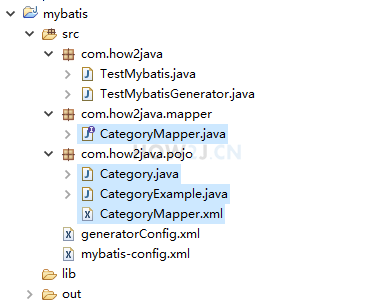步骤1:简介
步骤2:先运行,看到效果,再学习
步骤3:模仿和排错
步骤4:基于前面的知识点
步骤5:jar
步骤6:配置文件
步骤7:TestMybatisGenerator
步骤8:TestMybatis
步骤9:局限性
步骤 1 : 简介
Mybatis Generator是一个用于Mybatis逆向工程的工具。
前面学习的方式都是先有pojo, mapper, xml, 然后再创建表。
用逆向工程的方式,首先保证数据库里有表,然后通过Mybatis Generator生成pojo, mapper和xml。
可以节约大家的时间,提高开发效率,降低出错几率
步骤 2 : 先运行,看到效果,再学习
老规矩,先下载下载区(点击进入)的可运行项目,配置运行起来,确认可用之后,再学习做了哪些步骤以达到这样的效果。
运行 TestMybatisGenerator类,就可以观察到pojo,mapper和xml都生成了,然后再运行 TestMybatis 进行查询测试。
如图所示,运行TestMybatisGenerator之后,刷新项目可以看到自动生成的相关文件
注: CategoryExample 这个是用于多条件查询的,在TestMybatis中有演示

步骤 3 : 模仿和排错
在确保可运行项目能够正确无误地运行之后,再严格照着教程的步骤,对代码模仿一遍。
模仿过程难免代码有出入,导致无法得到期望的运行结果,此时此刻通过比较正确答案 ( 可运行项目 ) 和自己的代码,来定位问题所在。
采用这种方式,学习有效果,排错有效率,可以较为明显地提升学习速度,跨过学习路上的各个槛。
推荐使用diffmerge软件,进行文件夹比较。把你自己做的项目文件夹,和我的可运行项目文件夹进行比较。
这个软件很牛逼的,可以知道文件夹里哪两个文件不对,并且很明显地标记出来
这里提供了绿色安装和使用教程:diffmerge 下载和使用教程
步骤 4 : 基于前面的知识点
基于Mybatis 入门 这个知识点进行
步骤 5 : jar
需要额外的Mybatis Generator jar包(mybatis-generator-core-1.3.5.jar),在下载区(点击进入)下载,下载后放在lib目录下,并导入项目
导包办法:右键 project->properties->java build path->libaries->add external jars
步骤 6 : 配置文件
在src目录下创建generatorConfig.xml
这个配置文件有如下作用
1. 指定 mysql jdbcjar 包的位置,这里用的位置是 e:/project/mybatis/lib/mysql-connector-java-5.0.8-bin.jar
2. 设置数据库链接账号密码
3. 指定pojo,mapper,xml分别生成的包名
4. 指定表名以及表名对应的类名
4.1 使用自增长键:
|
<property name="my.isgen.usekeys" value="true"/>
<generatedKey column="id" sqlStatement="JDBC"/>
|
注1:如果IDE(eclipse或者idea) 项目里导入了jar包,那就不需要么第一步那样配置jar包的绝对路径了
|
<?xml version="1.0" encoding="UTF-8"?>
<!DOCTYPE generatorConfiguration
PUBLIC "-//mybatis.org//DTD MyBatis Generator Configuration 1.0//EN"
"http://mybatis.org/dtd/mybatis-generator-config_1_0.dtd">
<generatorConfiguration>
<!--数据库驱动-->
<!--
如果IDE(eclipse或者idea) 项目里导入了jar包,那么就不需要配置了jar包的绝对路径了
<classPathEntry location="e:/project/mybatis/lib/mysql-connector-java-5.0.8-bin.jar"/>
-->
<context id="DB2Tables" targetRuntime="MyBatis3">
<commentGenerator>
<property name="suppressDate" value="true"/>
<property name="suppressAllComments" value="false"/>
</commentGenerator>
<!--数据库链接地址账号密码-->
<jdbcConnection driverClass="com.mysql.jdbc.Driver"connectionURL="jdbc:mysql://localhost/how2java" userId="root" password="admin">
</jdbcConnection>
<javaTypeResolver>
<property name="forceBigDecimals" value="false"/>
</javaTypeResolver>
<!--生成Model类存放位置-->
<javaModelGenerator targetPackage="com.how2java.pojo" targetProject="src">
<property name="enableSubPackages" value="true"/>
<property name="trimStrings" value="true"/>
</javaModelGenerator>
<!--生成映射文件存放位置-->
<sqlMapGenerator targetPackage="com.how2java.pojo" targetProject="src">
<property name="enableSubPackages" value="true"/>
</sqlMapGenerator>
<!--生成Dao类存放位置-->
<javaClientGenerator type="XMLMAPPER" targetPackage="com.how2java.mapper"targetProject="src">
<property name="enableSubPackages" value="true"/>
</javaClientGenerator>
<!--生成对应表及类名-->
<table tableName="category_" domainObjectName="Category" enableCountByExample="false"enableUpdateByExample="false" enableDeleteByExample="false" enableSelectByExample="true"selectByExampleQueryId="false">
<property name="my.isgen.usekeys" value="true"/>
<generatedKey column="id" sqlStatement="JDBC"/>
</table>
<!-- <table tableName="product_" domainObjectName="Product" enableCountByExample="false" enableUpdateByExample="false" enableDeleteByExample="false" enableSelectByExample="false" selectByExampleQueryId="false"></table> -->
</context>
</generatorConfiguration>
|
步骤 7 : TestMybatisGenerator
运行成功之后,就会在对应位置生成pojo,xml,和mapper
|
package com.how2java;
import java.io.File;
import java.io.InputStream;
import java.util.ArrayList;
import java.util.List;
import org.mybatis.generator.api.MyBatisGenerator;
import org.mybatis.generator.config.Configuration;
import org.mybatis.generator.config.xml.ConfigurationParser;
import org.mybatis.generator.internal.DefaultShellCallback;
public class TestMybatisGenerator {
public static void main(String[] args) throws Exception {
List<String> warnings = new ArrayList<String>();
boolean overwrite = true;
InputStream is= TestMybatisGenerator.class.getClassLoader().getResource("generatorConfig.xml").openStream();
ConfigurationParser cp = new ConfigurationParser(warnings);
Configuration config = cp.parseConfiguration(is);
is.close();
DefaultShellCallback callback = new DefaultShellCallback(overwrite);
MyBatisGenerator myBatisGenerator = new MyBatisGenerator(config, callback, warnings);
myBatisGenerator.generate(null);
System.out.println("生成代码成功,刷新项目,查看文件,然后执行TestMybatis.java");
}
}
|
步骤 8 : TestMybatis
运行TestMybatis,执行自动生成的mapper,借助CategoryExample 进行模糊查询名称里出现了9的分类

|
package com.how2java;
import java.io.InputStream;
import java.util.List;
//import com.how2java.mapper.CategoryMapper;
//import com.how2java.pojo.Category;
//import com.how2java.pojo.CategoryExample;
//import com.how2java.mapper.CategoryMapper;
//import com.how2java.pojo.CategoryExample;
import org.apache.ibatis.io.Resources;
import org.apache.ibatis.session.SqlSession;
import org.apache.ibatis.session.SqlSessionFactory;
import org.apache.ibatis.session.SqlSessionFactoryBuilder;
import com.how2java.mapper.CategoryMapper;
import com.how2java.pojo.Category;
import com.how2java.pojo.CategoryExample;
public class TestMybatis {
public static void main(String args[]) throws Exception {
System.out.println("先运行TestMybatisGenerator创建mapper,pojo,xml 等文件,然后取消import里被注释的,以及接下来的注释,并执行代码");
//
String resource = "mybatis-config.xml";
InputStream inputStream = Resources.getResourceAsStream(resource);
SqlSessionFactory sqlSessionFactory = new SqlSessionFactoryBuilder().build(inputStream);
SqlSession session=sqlSessionFactory.openSession();
CategoryExample example = new CategoryExample();
example.createCriteria().andNameLike("%9%");
CategoryMapper mapper = session.getMapper(CategoryMapper.class);
List<Category> cs= mapper.selectByExample(example);
for (Category c : cs) {
System.out.println(c.getName());
}
}
}
|
步骤 9 : 局限性
多对一,一对多需要自己手写,这个工具目前(20170828版本1.3.5)不提供
更多内容,点击了解: https://how2j.cn/k/mybatis/mybatis-generator/1376.html


